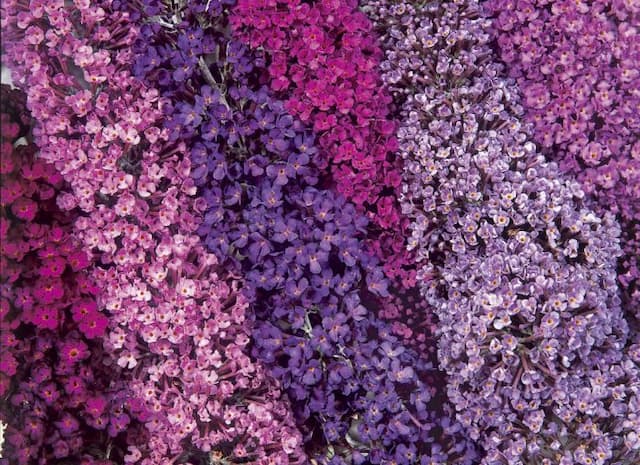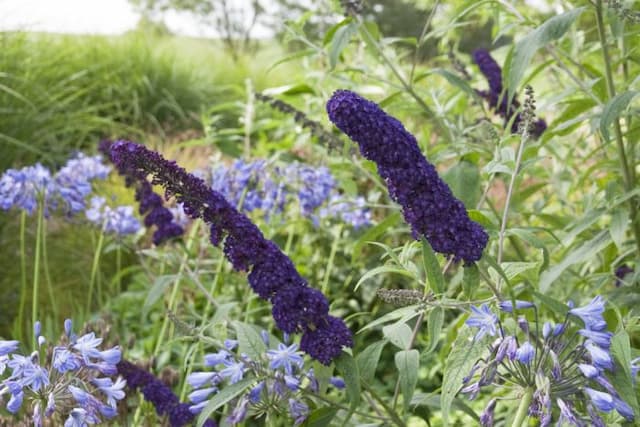Nettle-leaved Mullein Verbascum chaixii

ABOUT
Verbascum chaixii, commonly known as nettle-leaved mullein, is a herbaceous plant that is well-known for its attractive flowers and foliage. It typically bears a basal rosette of leaves that are somewhat ovate in shape and are characterized by their textured surface, looking almost like a nettle, which is where the name originates. The leaves are usually dark green, at times with a grayish undertone, and can be covered with a fine, downy fuzz that gives them a soft, velvety appearance. The plant is adorned with tall, erect flowering stalks that rise vertically, showcasing beautiful floral spires. These flowers are arranged in a dense, elongated cluster along the upper part of the stalks. Each flower is small and cup-shaped, possessing a lovely shade that ranges from creamy white to yellow, often having a purple center which adds a touch of elegance to the overall floral display. The stamens within the flowers are prominent and can have striking orange or purple filaments with darker anthers, creating a stunning contrast against the softer colors of the petals. Nettle-leaved mullein blooms during the warmer months, producing flowers that not only add an ornamental quality to gardens but are also attractive to various pollinators, including bees and butterflies. The arrangement of the flowers along the spire can be quite dense, providing a lush, vertical element to the plant's structure. After flowering, the plant will produce seed capsules that enable self-seeding for propagation. This aspect allows nettle-leaved mullein to naturalize in the garden environment, often popping up in new locations within the garden. Despite its robust and somewhat wild look, this plant is often valued in garden designs for its vertical accent and the soothing, pastel colors of its blooms.
About this plant
 Names
NamesFamily
Scrophulariaceae
Synonyms
Nettle-leaved Mullein, Chaix Mullein
Common names
Verbascum nigrum var. chaixii, Verbascum chaixii var. chaixii.
 Toxicity
ToxicityTo humans
Verbascum chaixii, commonly known as nettle-leaved mullein, is not generally known for its toxicity to humans. There is limited information available on the toxicity of this specific species, and it is not typically listed as a poisonous plant. While various Verbascum species have been used in traditional herbal medicine, it's always wise to approach any plant with caution. If ingested in large quantities or without proper preparation, there is a potential for gastrointestinal discomfort or allergic reactions. Ingesting any plant not typically consumed as food should be done under the guidance of a knowledgeable herbalist or healthcare provider to avoid adverse consequences.
To pets
Nettle-leaved mullein is not widely recognized for being toxic to pets. Similar to the information regarding its effects on humans, there is limited data on its toxicity to animals like cats and dogs. Most Verbascum species are not listed as toxic to pets. However, it's always prudent to prevent pets from ingesting plants that are not part of their usual diet, as they could potentially cause mild gastrointestinal upset or an allergic reaction. If you suspect your pet has ingested nettle-leaved mullein or is showing symptoms of distress, consult your veterinarian.
 Characteristics
CharacteristicsLife cycle
Biennials
Foliage type
Deciduous
Color of leaves
Green
Flower color
Yellow
Height
2-3 feet (0.6-0.9 meters)
Spread
1 foot (0.3 meters)
Plant type
Herb
Hardiness zones
5
Native area
Europe
Benefits
 General Benefits
General Benefits- Ornamental Value: Verbascum chaixii, known as nettle-leaved mullein, adds visual interest to gardens with its tall spires of flowers.
- Drought Tolerance: It is well-suited for xeriscaping because of its ability to withstand dry conditions.
- Pollinator Attraction: The flowers attract bees, butterflies, and other pollinators, supporting local ecosystems.
- Low Maintenance: Nettle-leaved mullein requires minimal care once established, making it a good choice for novice gardeners.
- Frost Resistance: This plant can survive in cold temperatures, making it suitable for gardens in cooler climates.
- Versatility: It can be used in various garden styles, including cottage gardens, gravel gardens, and borders.
- Deer Resistance: It is generally resistant to deer grazing, which can be beneficial in areas with large deer populations.
- Biennial Lifecycle: In its two-year lifecycle, it provides seasonal interest and allows gardeners to plan for succession planting.
 Medical Properties
Medical Properties- Anti-inflammatory: Verbascum chaixii has been traditionally used for its anti-inflammatory properties to relieve conditions such as skin inflammation or respiratory inflammation.
- Demulcent: The plant is known to contain mucilage, which can help soothe irritated or inflamed mucous membranes in the throat and digestive system.
- Expectorant: Historically, Verbascum chaixii has been used to treat respiratory conditions by helping to clear mucus from the lungs, bronchi, and trachea.
- Diuretic: It has been employed as a diuretic to increase urine flow and relieve fluid retention.
- Antiseptic: The extracts of Verbascum chaixii have been used for their antiseptic qualities in the treatment of minor wounds and infections.
- Analgesic: The plant has been used to alleviate pain, particularly in the case of minor sores and wounds.
- Astringent: Verbascum chaixii may have astringent properties, which help to tighten and tone the skin or mucous membranes, and reduce secretions.
 Air-purifying Qualities
Air-purifying QualitiesThis plant is not specifically known for air purifying qualities.
 Other Uses
Other Uses- Verbascum chaixii, commonly known as nettle-leaved mullein, has been used historically as a fish poison; compounds within the plant can temporarily incapacitate fish, making them easier to catch.
- In dyeing, the flowers of nettle-leaved mullein provide a source of yellow to greenish-yellow dye for textiles when used with suitable mordants.
- The soft leaves can be used as an emergency toilet paper due to their large size and soft texture, a practice that dates back to ancient times.
- Gardeners may use the tall, distinctive stalks of nettle-leaved mullein as natural stakes or supports for other, more fragile plants in their gardens.
- The hairiness of the nettle-leaved mullein leaves has enabled their use as a wick material in the making of traditional oil lamps and candles.
- Culinary experimentation has seen the flowers of nettle-leaved mullein used to infuse flavor into syrups and liqueurs, although this is quite rare and unconventional.
- The plant's rosettes have been used as a rough scouring pad to clean metal items due to their coarse texture.
- The seed fluff of nettle-leaved mullein can be used as a tinder for starting fires, as it catches a spark easily and can help in building a flame.
- In floral arrangements, the striking spikes of nettle-leaved mullein flowers add vertical interest and a rustic look to bouquets and dried flower displays.
- Some people have used the dried stalks of nettle-leaved mullein as a natural insulation material in small-scale crafting and building projects due to their fibrous nature.
Interesting Facts
 Feng Shui
Feng ShuiThe plant Verbascum, commonly known as Nettle-leaved Mullein, is not used in Feng Shui practice.
 Zodiac Sign Compitability
Zodiac Sign CompitabilityThe plant Nettle-leaved Mullein is not used in astrology practice.
 Plant Symbolism
Plant Symbolism- Healing: Verbascum chaixii, commonly known as 'Nettle-leaved mullein', has been used in traditional medicine for its purported healing properties, particularly in treating respiratory ailments. Its symbolism of healing stems from this historical use.
- Protection: The downy leaves of the Nettle-leaved mullein were once thought to ward off evil spirits and negative energies, symbolizing protection.
- Purification: In some cultures, mullein is associated with cleansing rituals, symbolizing purification of the spirit or the physical self.
 Water
WaterNetleaf Mullein, Verbascum chaixii, prefers well-drained soil and does not require frequent watering. Water deeply but infrequently, allowing the soil to dry out slightly between waterings. As a general guideline, provide about 1 inch of water per week during the growing season. During hotter, drier periods, you may need to water every 5 to 7 days, whereas in cooler, wetter conditions, watering every 10 to 14 days might suffice. Adjustments should be made based on rainfall and the specific conditions of your garden.
 Light
LightNetleaf Mullein thrives best in a spot that receives full sun. It requires at least 6 hours of direct sunlight each day to ensure robust growth and good flower production. If placing indoors, a south-facing window is typically the most suitable location.
 Temperature
TemperatureNetleaf Mullein is hardy and can tolerate a wide temperature range. It can generally survive temperatures as low as 20 degrees Fahrenheit and as high as 80 degrees Fahrenheit. The ideal temperature for optimal growth would be between 50 and 70 degrees Fahrenheit.
 Pruning
PruningNetleaf Mullein should be pruned to remove spent flowers and promote additional blooming. Pruning can also help maintain the plant's shape and prevent self-seeding if desired. The best time to prune is immediately after the flowers fade, typically in late summer or early fall.
 Cleaning
CleaningAs needed
 Soil
SoilThe nettle-leaved mullein thrives in well-draining soil with a neutral to slightly alkaline pH, ranging from 6.5 to 7.5. A mix containing loam, sand, and a small amount of compost is ideal to provide the necessary nutrients and drainage.
 Repotting
RepottingNettle-leaved mullein typically does not require frequent repotting and can be done every 2-3 years or when the plant outgrows its current container.
 Humidity & Misting
Humidity & MistingNettle-leaved mullein is tolerant of a wide range of humidity levels and does best in moderate ambient humidity, without the need for any special humidity adjustments.
 Suitable locations
Suitable locationsIndoor
Ensure full sun and well-draining soil mix.
Outdoor
Plant in full sun, well-draining soil, annual mulching.
Hardiness zone
5-8 USDA
 Life cycle
Life cycleVerbascum chaixii, known as nettle-leaved mullein, begins its life cycle as a seed, which upon germination, initiates the development of a rosette of leaves at the soil surface. This basal rosette, true to its biennial nature, stores energy in its first year while remaining generally inconspicuous. In its second year, the plant rapidly elongates its stem to produce a towering flower stalk, which can reach up to 2 meters, bearing intricate yellow flowers with purple stamens typically from June to September. After pollination, which is facilitated by insects, the flowers develop into seed capsules that release numerous tiny seeds. These seeds, depending on conditions, may lie dormant in the soil until favorable growth conditions arise, completing the plant's life cycle when they germinate and begin a new generation. Post seed dispersal, the adult plant usually dies back, having completed its biennial growth strategy.
 Propogation
PropogationPropogation time
Spring to Summer
The most popular method of propagating Verbascum chaixii, commonly known as nettle-leaved mullein, is by seed. Propagation should ideally take place in late spring or early summer. Seeds can be directly sown into a well-draining soil medium and should be lightly covered with soil. The soil needs to be kept moist until germination, which usually occurs within 2 to 3 weeks. Once seedlings have developed and are large enough to handle, they should be transplanted to their final position, ensuring they are spaced approximately 18 inches (around 45 centimeters) apart to allow for mature growth.


![Butterfly bush [Adonis Blue]](/_next/image?url=https%3A%2F%2Fplants-admin.emdemapps.com%2Fimages%2Fplants%2F%2Fimages%2F604b56e58f983.png&w=640&q=75)


![Butterfly bush [Buzz Ivory]](/_next/image?url=https%3A%2F%2Fplants-admin.emdemapps.com%2Fimages%2Fplants%2F%2Fimages%2F604b57987dfa8.png&w=640&q=75)
![Butterfly bush [Camberwell Beauty]](/_next/image?url=https%3A%2F%2Fplants-admin.emdemapps.com%2Fimages%2Fplants%2F%2Fimages%2F604b5ead04c12.png&w=640&q=75)


